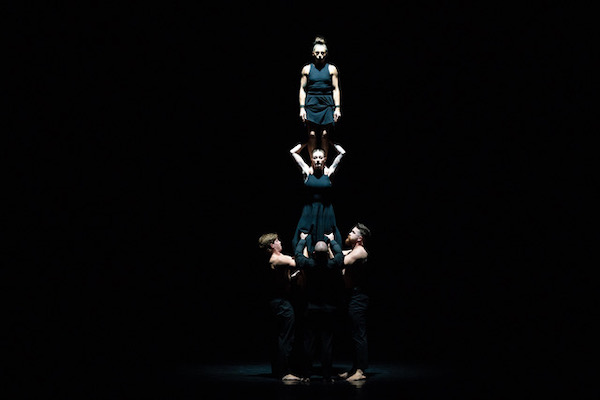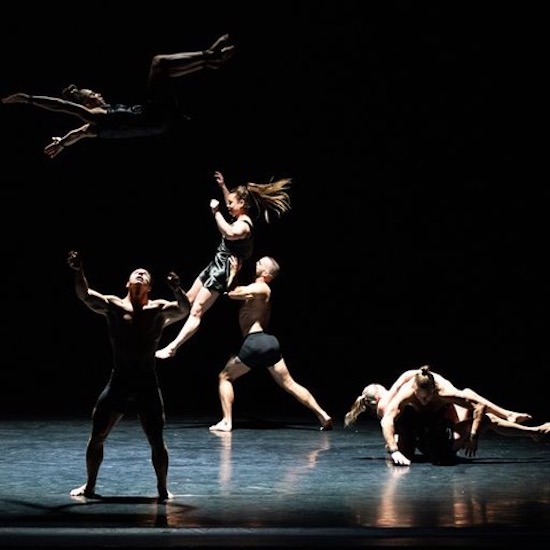Dance Review: Circa’s “Sacre” — Breathtaking Acrobatics
By Jessica Lockhart
Circa has come up with a stunning way to combine the athleticism of circus training with the aesthetics of dance theater.
Sacre performed by Circa. Presented by Celebrity Series at the Shubert Theater, Boston

Circa performers in Sacre. Photo: Robert Torres
Remember going to the circus as a young kid? Watching wide-eyed as you saw fearless acrobats and high-wire daredevils? Now, fast forward to 2023 — once again, the circus has come to town. This version, called Circa, has been tailored for adults, but the wow factor is still the main attraction.
The members of Circa are acrobats, and they have the power to create the breathtaking physical theatricality found in circuses of the past — and without the help of clowns, lion-tamers, and jugglers. These performers are athletes who have no use for props; their instruments are their powerful bodies. They are as lithe and poised as ballet dancers, but there was nothing classical in this performance. The strength and agility of all 10 performers was jaw-dropping, a graceful muscularity that extended to how they lifted and carried and stacked bodies. They seemed to defy human limitations as well as gravity. How could one person support two other people standing atop their shoulders? Beautiful shapes were concocted out of impossible combinations: two, three, and even four bodies wrapped together. It was showy and outrageous — with no tents or nets in sight.
This contemporary circus troupe is from Australia and its 65-minute show Sacre was inspired by the Rite of Spring, Igor Stravinsky’s dark and groundbreaking 1913 ballet. The now classic musical score was unusual at the time because of the modernistic dissonance and jagged rhythms. The piece dramatized a primitive spring ritual dedicated to ensuring fertility: as a sacrifice to the gods, a girl was danced to her death. Famously, the Ballet Russes premiered the piece. Circa’s new incarnation is its wild rendering of Stravinsky’s drama of death and desire.
Circa’s artistic director, Yaron Lifschitz, says that his choreographic vision was “to confront and explore interconnectivity, human sexual desires, and our relationship with divinity.” He initially set up a sense of fear as the dancers entered the stage. They moved skeptically, moving in and out of a circle of light, often stopping to look around for threats. (The circle might have been a nod to the origin of the word circus, which is kirkos, meaning circle or ring.) Murky lighting made it difficult to make out the action. The haunting sound of wailing horns added to our disorientation. (The performance’s first half featured a score by Phillippe Bachman.) As the dance progressed, the acrobats began moving faster and faster, tumbling and jumping to the floor. They caught each other as they jumped into the air, lifting others overhead and spinning them around. For the audience, the action was exhilarating, though there was an undercurrent of trepidation. We watched with breath held, hoping that the performer tossed through the air would be caught before he or she hit the ground.

Circa performers in Sacre. Photo: Robert Torres
Worthy of note: just how capably the female acrobats performed along with their male counterpoints. The women did as much as the men when it came to partnering and supporting others in lifts and balances. The women also had multiple people draped upon them, and they stood tall with three or four people’s weight bearing down upon them. The person at the base, both male and female, could be seen shaking as people piled on, but they stood firm and completed each routine.
The dance’s second half followed Stravinsky’s iconic score, which became more brutal and pressing. The dancers were driven by the pounding sound and they moved relentlessly. In quieter sections the performers created beautiful sculptural shapes out of an assemblage of their bodies. At times, they contorted themselves into precarious positions that seemed to be inconceivable for human beings to maintain — yet they continually defied the laws of gravity. Audience members appreciated the skill of the performers with childlike enthusiasm; they would clap after a particularly eye-popping show of strength and balance. The were having fun, just like when they were kids at the circus.
Circa has come up with a stunning way to combine the athleticism of circus training with the aesthetics of dance theater. Adult circus was popularized by Cirque du Soleil in the ’80s. This Australian troupe is building on that tradition in very muscular ways.
Jessica Lockhart is a National Endowment for the Arts Fellow in Dance Criticism and has a BA in Communication from the University of Southern Maine. Lockhart is a Maine Association of Broadcasters award-winning independent journalist. Currently, she also works as program director at WMPG Community radio.
